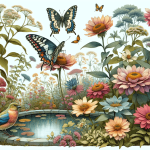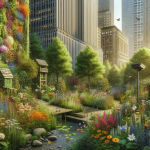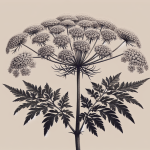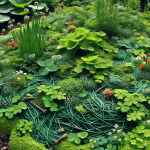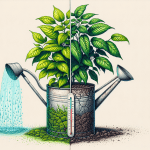This post may contain affiliate links. As an Amazon Associate, we may earn commissions from qualifying purchases.
Imagine stepping outside your door to a garden that’s a riot of color in every season. From the first tender shoots of spring to the hearty blooms bracing against winter’s chill, creating a year-round garden with flowers that bloom in different seasons is not only possible but can transform your outdoor space into a personal retreat that celebrates the cyclical beauty of nature. In this guide, you’ll discover the secrets to cultivating a vibrant, ever-blooming garden by selecting the right plants that will keep your garden lively and welcoming throughout the year.
Understanding Seasonal Blooms
Creating a year-round garden with a colorful display of flowers requires a good understanding of the growth cycles of plants and how they relate to the seasons. By learning the basics of how plants grow, you can plan a garden that has visual appeal throughout the year.
The basics of plant growth cycles
Plants have a natural life cycle that determines when they grow, bloom, and go dormant. This cycle is influenced by environmental factors such as temperature, light, and water. Some plants grow and bloom in the spring, then die back in the winter, while others may bloom in the autumn and stay green through the winter.
Understanding the seasons in your local climate
The key to a successful year-round garden is understanding your local climate and how the seasons change in your area. Knowing when to expect frost, heatwaves, and rainy seasons can help you select plants that will thrive in your garden throughout the year.
Annuals vs. perennials: Benefits and limitations
Annuals are plants that complete their life cycle in one year, from seed to bloom to death. They’re great for adding immediate color to your garden but need to be replanted each year. Perennials, on the other hand, come back year after year, often growing larger with each season. While they may take longer to establish and bloom, they offer a long-term solution for maintaining consistent color in your garden.
Planning Your Year-Round Garden
To ensure your garden has a continuous display of flowers, it’s essential to plan. Setting garden goals, considering color schemes, and creating a bloom calendar can help you design a garden that looks great in every season.
Setting garden goals and themes
Start by deciding what you want to achieve with your garden. Are you looking for a relaxing retreat, a wildlife haven, or an outdoor space for entertaining? Setting clear goals can guide your choice of plants and garden layout.
Considering color schemes and aesthetics
Consider the overall look you’re aiming for, including colors, textures, and forms. A well-thought-out color scheme can help create a cohesive and visually appealing garden throughout the year.
Creating a bloom calendar
A bloom calendar can help you plan so that you have a succession of flowers blooming in your garden. By noting when each plant blooms, you can ensure that there are always a few plants in bloom at any time of the year.
Incorporating evergreens and foliage plants for continuous interest
Evergreens and plants with interesting foliage can provide a backdrop of color even when other plants are dormant. They add structure and interest to the garden year-round.

Selecting Plants for Each Season
Choosing the right plants for each season is crucial to creating a garden that offers year-round interest.
Choosing winter-blooming plants
Look for plants that bloom in winter or early spring, such as witch hazel, winter jasmine, and early bulbs like snowdrops. These can bring life to your garden even in the coldest months.
Selecting spring flowers for early color
Spring-blooming flowers like daffodils, tulips, and cherry blossoms add a burst of color after the winter gloom. They’re also a welcome sign that warmer weather is on the way.
Incorporating summer bloomers for peak vibrancy
Summer is the time for vibrant, show-stopping flowers. Plants like roses, daylilies, and hydrangeas can add a splash of color to your garden in the summer months.
Adding fall flowering plants for late-season beauty
As the days grow shorter, plants like chrysanthemums, asters, and Japanese anemones can provide a final flourish of color before winter sets in.
Soil Preparation and Improvement
Healthy soil is the foundation of a thriving garden. Preparing and improving your soil can help ensure that your plants are healthy and vibrant.
Testing and understanding your soil type
Testing your soil can help you understand its texture, nutrient levels, and pH balance. This information is crucial for selecting the right plants and amendments for your garden.
Amending soil for optimal plant health
Depending on your soil test results, you may need to add compost, manure, or other amendments to improve soil fertility and structure.
Mulching for temperature and moisture control
Mulching helps regulate soil temperature, retain moisture, and suppress weeds. It’s an important step in preparing your garden for each season.

Plant Care and Maintenance
Regular care and maintenance are essential for a healthy, blooming garden.
Watering needs throughout the seasons
Plants have different watering needs depending on the season and their growth cycle. Understanding these needs can help you avoid over- or under-watering.
Pruning and deadheading for continuous blooms
Regular pruning and deadheading can encourage plants to produce more flowers and extend their blooming period.
Protecting plants from pests and diseases
Monitoring your garden for signs of pests and diseases can help you address problems before they damage your plants.
Seasonal fertilizing for optimal growth
Applying the right type of fertilizer at the right time can support healthy growth and abundant blooms.
Incorporating Bulbs into the Garden
Bulbs can be a fantastic addition to the year-round garden, offering blooms from early spring to late fall.
Timing for planting bulbs
Understanding when to plant different bulbs is crucial for success. Fall is typically the time to plant spring-blooming bulbs, while many summer-blooming bulbs are planted in the spring.
Layering bulbs for staggered blooms
By planting bulbs at different depths, you can create a succession of blooms from early spring to late fall.
Care and maintenance of garden bulbs
After blooming, it’s important to care for bulbs by removing spent flowers and allowing foliage to die back naturally.
Using Container Gardening
Containers offer flexibility in a year-round garden and can be used to grow plants that might not thrive in your garden soil.
Benefits of containers in a year-round garden
Containers allow you to control the soil and growing conditions for each plant and can be moved to suit changing light and temperature conditions.
Choosing the right containers
Selecting the right size and material for your containers can help ensure the health of your plants.
Container care and overwintering strategies
Some plants in containers may need special care or protection to survive the winter months.
Leveraging Vertical Space
Vertical gardening can add dimension to your garden and is especially useful in small spaces.
Incorporating trellises and vertical planters
Trellises, vertical planters, and climbing plants can help you maximize space and add height to your garden.
Selecting climbing plants and vines for year-round interest
Climbing plants like ivy, clematis, and some roses can provide color and interest at eye level and above.
Maximizing small spaces with vertical gardening techniques
Vertical gardening techniques can help you create a lush, full garden even if you’re working with limited space.
Integrating Hardscape Elements
Hardscape elements like paths, rocks, and water features can add year-round interest to your garden.
Designing with paths, rocks, and water features
These elements can provide structure and focal points in your garden, guiding the eye and encouraging exploration.
Using garden art for year-round interest
Garden art can add personality to your garden and provide interest even when plants are dormant.
Creating focal points and seating areas
Strategically placed seating areas and focal points can encourage you to spend time in your garden throughout the year.
Sustainable Gardening Practices
Implementing sustainable practices can help your garden thrive while minimizing its impact on the environment.
Implementing composting for soil health
Composting turns kitchen and garden waste into rich soil amendments, reducing waste and improving soil health.
Choosing native plants for resilience and biodiversity
Native plants are adapted to your local climate and support local wildlife, promoting a healthy, resilient garden ecosystem.
Water conservation strategies
Using drought-tolerant plants, rain barrels, and efficient watering techniques can help you conserve water in your garden.
Promoting pollinators and beneficial insects
Selecting plants that attract pollinators and beneficial insects can help control pests and ensure your garden is productive and healthy.
By following these guidelines and making thoughtful choices about planning, plant selection, and care, you can create a beautiful, thriving garden that offers color and interest in every season.

